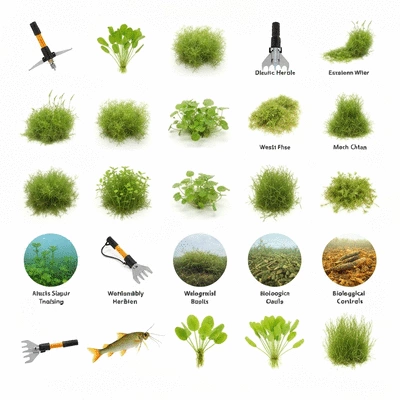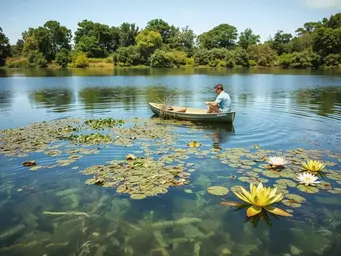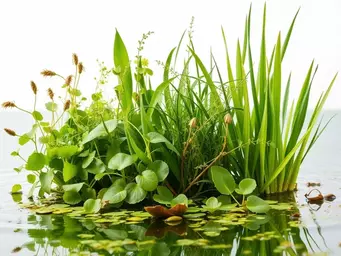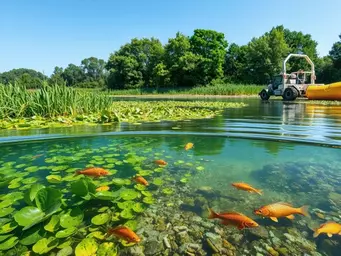
Managing Aquatic Weeds Effectively
As we delve into the hidden challenges of our water ecosystems, understanding the role of aquatic weeds becomes crucial. These plants may seem innocuous, but they can wreak havoc on water quality and biodiversity. Let’s explore the significant lessons learned from examining these invasive species.
What You Will Learn
- Aquatic weeds disrupt local ecosystems by competing for resources and dominating native plant species.
- Unchecked growth of these weeds can lead to serious environmental and economic impacts, including reduced biodiversity and increased management costs.
- Eutrophication, often driven by human activity, creates ideal conditions for invasive plants to proliferate by increasing nutrient levels in water bodies.
- Effective aquatic weed management requires an integrated approach, utilizing physical, biological, and chemical control methods tailored to specific environments.
- Community engagement and education are vital for successful aquatic weed management, fostering a sense of responsibility and proactive action among residents.
Aquatic Weed Management: Key Challenges and Solutions
This visual outlines the primary challenges posed by aquatic weeds and the integrated strategies for effective management, highlighting the cyclical nature of eutrophication and the multi-faceted approach required for control.
Challenges of Aquatic Weeds
- 🌿 Invasive Growth
- 📉 Decreased Biodiversity
- 💧 Water Quality Issues
- 🚣 Recreational Impacts
- 💸 Commercial Costs
Eutrophication Cycle
Best Practices for Control
- 🛠️ Physical & Biological Controls
- 📊 Nutrient Management
- 👁️ Regular Monitoring
- 📚 Education & Awareness
- 🤝 Community Engagement
Impacts on Ecosystem Health
- 📉 Oxygen Depletion
- 🏡 Habitat Alteration
- 🤒 Human Health Risks
- 🌱 Smother Native Plants
- 🐟 Decline of Native Fauna
Understanding the Impact of Aquatic Weeds in Water Bodies
When we think about our beautiful lakes and rivers, it’s easy to overlook what lurks beneath the surface. Aquatic weeds can be more than just an eyesore; they pose significant challenges to water quality and ecosystem health. But what exactly are these aquatic weeds, and why should we be concerned about their presence?
What Are Aquatic Weeds and Why Are They a Concern?
Aquatic weeds are any plant species that grow in water and can create problems for local ecosystems. They often include invasives like hydrilla and water hyacinth, which can spread rapidly and dominate water bodies. The concern lies in their ability to disrupt the natural balance of aquatic environments, affecting everything from fish populations to recreational activities. For more detailed information on identifying and managing these species, resources like this illustrated guide from the Washington State Department of Ecology can be invaluable.
- Invasive Growth: Some species can double in size within days, smothering native plants.
- Decreased Biodiversity: They compete for resources, often leading to the decline of native flora and fauna.
- Water Quality Issues: Overgrowth can lead to lower oxygen levels, impacting aquatic life.
As someone who has seen the devastating effects of unchecked weed growth firsthand, I believe it’s crucial for us to recognize these challenges. Understanding aquatic weeds is the first step to managing them effectively.

The Environmental and Economic Consequences of Unchecked Growth
The unchecked proliferation of aquatic weeds can lead to severe environmental and economic consequences. A water body overwhelmed by invasive species can lose its natural beauty and function, impacting various stakeholders. Learn more about the comprehensive strategies employed by various states to combat these issues, such as the Aquatic Weed Control Program in North Carolina.
- Recreational Impacts: Boating, fishing, and swimming can become nearly impossible due to dense weed growth.
- Commercial Costs: Local economies that rely on tourism and fisheries can suffer significant financial losses.
- Increased Management Expenses: Landowners and municipalities may incur high costs for removal and control measures.
By addressing these issues proactively, we can minimize both environmental damage and economic burdens. The goal is to restore balance to our cherished waterways.
The Role of Eutrophication in Aquatic Weed Proliferation
Eutrophication is a natural process that can be exacerbated by human actions, leading to nutrient over-enrichment in water bodies. This phenomenon creates ideal conditions for aquatic weeds to flourish. When excess nutrients, particularly phosphorus, enter our waterways from runoff, they can trigger explosive weed growth. Understanding this process is key to effective management, as detailed in resources like this publication on nutrient management from New Mexico State University.
- Causes of Eutrophication: Common sources include agricultural runoff, wastewater discharge, and urban runoff.
- Consequences: Algal blooms can occur, further depleting oxygen and harming aquatic life.
- The Cycle: As weeds die and decompose, they release more nutrients, fueling further growth.
Fighting this cycle requires a commitment to reducing nutrient inputs and promoting sustainable practices. We can enhance our understanding of eutrophication to better manage aquatic ecosystems.
How Aquatic Weeds Affect Water Quality and Ecosystem Health
Aquatic weeds can significantly influence water quality and the overall health of ecosystems. They not only compete for sunlight and nutrients but also alter the physical and chemical properties of water. This alteration can lead to a variety of issues, including poor water clarity and decreased oxygen levels.
- Oxygen Depletion: Dense weed growth can lead to hypoxic conditions, harming fish and other aquatic organisms.
- Habitat Alteration: Weeds can change habitat structures, making it harder for native species to thrive.
- Human Health Risks: Some aquatic weeds can produce toxins, posing health risks for swimmers and wildlife.
As we work to manage these weeds at Aquatic Weed Solutions, our goal is clear: to restore and maintain the ecological balance of our water bodies. By understanding the impacts of aquatic weeds, we empower ourselves to take action for healthier ecosystems.
Pro Tip
Did you know? Integrating native plant species into your aquatic ecosystem can significantly reduce the growth of invasive aquatic weeds. By fostering a balanced environment, native species can compete for resources and help maintain a healthy habitat. Consider incorporating native flora as part of your long-term weed management strategy!
Frequently Asked Questions About Aquatic Weed Management
What are aquatic weeds and why are they a concern?
Aquatic weeds are plant species that grow in water and can cause problems for local ecosystems. They are a concern because they can disrupt the natural balance of aquatic environments, leading to decreased biodiversity, poor water quality, and negative impacts on recreational activities and commercial interests.
How does eutrophication contribute to aquatic weed growth?
Eutrophication is the process of nutrient over-enrichment in water bodies, often caused by human activities like agricultural and urban runoff. This excess of nutrients, particularly phosphorus, creates ideal conditions for aquatic weeds to grow rapidly. As these weeds die and decompose, they release more nutrients, fueling a continuous cycle of explosive growth.
What are the main environmental impacts of unchecked aquatic weed growth?
Unchecked aquatic weed growth can lead to several environmental impacts, including decreased biodiversity due to competition with native plants, oxygen depletion in the water which harms aquatic life, and alteration of natural habitats. Some weeds can also produce toxins, posing risks to human health and wildlife.
What are the best practices for controlling aquatic weeds?
Effective aquatic weed control requires an integrated approach combining physical methods (like barriers and dredging), biological controls (using native species), and targeted chemical applications. Nutrient management, regular monitoring, and community education are also crucial for successful long-term management.
Why is community engagement important in aquatic weed management?
Community engagement is vital because it raises awareness, fosters a sense of ownership, and encourages collective action. Local residents can participate in workshops, volunteer clean-up efforts, and citizen science projects, contributing to healthier waterways and more sustainable management outcomes.
Summarizing Best Practices for Aquatic Weed Control
As I reflect on my years of experience in aquatic weed management, it’s clear that an integrated approach leads to the most successful outcomes. The best practices for controlling aquatic weeds involve a combination of physical, biological, and chemical strategies tailored to the specific needs of your water body. By understanding the unique characteristics of your ecosystem, you can effectively manage these invaders and restore balance.
Here’s a concise list of best practices to consider when tackling aquatic weeds:
- Utilize a combination of physical and biological controls to minimize weed growth.
- Implement nutrient management strategies to reduce the conditions that favor weed proliferation.
- Engage in regular monitoring and assessment to catch issues early.
- Educate yourself and others about the various aquatic weed species and their management.
It’s essential to remember that no single method will work universally. Instead, the key lies in integrating these strategies to tailor your approach to the specific challenges of your waterway.

Integrating Multiple Strategies for Effective Management
When it comes to managing aquatic weeds, I’ve found that combining different methods often yields the best results. For instance, using mechanical removal in conjunction with biological controls like native fish can create a more robust defense against invasive species. This synergy not only helps in controlling weeds but also supports the overall health of your aquatic ecosystem.
Here are some effective strategies to integrate:
- Physical methods: Barriers, shading, and dredging can significantly reduce weed growth.
- Biological controls: Using native species to maintain a balanced ecosystem is crucial.
- Chemical applications: Targeted herbicides can be effective when used judiciously.
- Regular monitoring: Keeping an eye on changes in your water body can help you adapt your strategies.
Remember, each water body is unique, and what works well in one location might not be effective in another. Always assess your local conditions and adjust your practices accordingly!
Tailoring Approaches Based on Regional and Climate-Specific Needs
In my work with landowners and ecologists, I’ve seen how regional differences influence aquatic weed proliferation. Factors such as climate, local flora and fauna, and water quality all play significant roles in determining the best management strategies. Tailoring your approaches based on these unique aspects can dramatically enhance the effectiveness of your efforts.
Here are some considerations for customizing your strategies:
- Assess the local climate and seasonality to understand the growth patterns of aquatic weeds.
- Identify native plant species that can outcompete invasive weeds in your region.
- Work with local experts to develop a comprehensive management plan that reflects regional needs.
- Engage with community members to share insights and gather additional support for your initiatives.
By taking the time to understand your specific environment, you're not just managing weeds; you're fostering a healthier ecosystem that benefits everyone!
Encouraging Sustainable Practices in Aquatic Management
At Aquatic Weed Solutions, we believe that sustainable practices in aquatic management are essential for the health of our waterways. By encouraging community engagement and education, we can empower individuals to take action and contribute to the long-term success of their aquatic environments.
Fostering Community Engagement in Water Body Management
One of the most impactful ways to ensure the success of aquatic management initiatives is through community involvement. Involving local residents not only raises awareness but also fosters a sense of ownership and responsibility toward our precious water bodies.
Here are some ways to engage your community:
- Organize workshops focused on aquatic weed identification and control techniques.
- Form local volunteer groups to participate in clean-up and management efforts.
- Set up community challenges to promote awareness and action against aquatic weeds.
- Utilize social media to share success stories and best practices.
By creating a community network, we can collectively enhance the management of our ecosystems, leading to healthier waters for all!
Resources for Ongoing Education and Support in Aquatic Weed Control
Continuing education plays a vital role in effective aquatic weed management. At Aquatic Weed Solutions, we provide various resources that can help landowners, ecologists, and managers stay informed and empowered.
- Illustrated guides for species identification that simplify the weed management process.
- Online courses covering various control methods and best practices.
- Access to expert insights through webinars and community forums.
- Periodic newsletters with updates on new research and management strategies.
Staying informed is key to combating aquatic weeds effectively!
Public Awareness Campaigns for Effective Weed Management
Public awareness is a powerful tool in the management of aquatic weeds. By launching campaigns that highlight the importance of aquatic ecosystems and the threats posed by invasive weeds, we can motivate individuals to take action.
- Conduct educational events at local schools to teach students about aquatic ecosystems.
- Distribute informative brochures at community centers and parks.
- Collaborate with local media to share stories of successful weed management efforts.
- Encourage citizen science projects to involve the community in monitoring invasive species.
By raising awareness, we can inspire collective action that leads to healthier waterways for future generations!
Recap of Key Points
Here is a quick recap of the important points discussed in the article:
- Aquatic weeds disrupt local ecosystems, affecting biodiversity and water quality.
- Eutrophication from nutrient runoff exacerbates aquatic weed growth, leading to harmful algal blooms.
- Integrated management strategies combining physical, biological, and chemical methods are essential for effective aquatic weed control.
- Community engagement is crucial for raising awareness and fostering ownership of waterway management efforts.
- Regular monitoring and adaptive management based on local conditions enhance the effectiveness of control strategies.





Managing Aquatic Weeds Effectively
Impact of Aquatic Weeds on Recreation
Understanding Aquatic Weed Varieties
Integrated Aquatic Weed Management Methods
Integrated Approaches to Aquatic Weeds